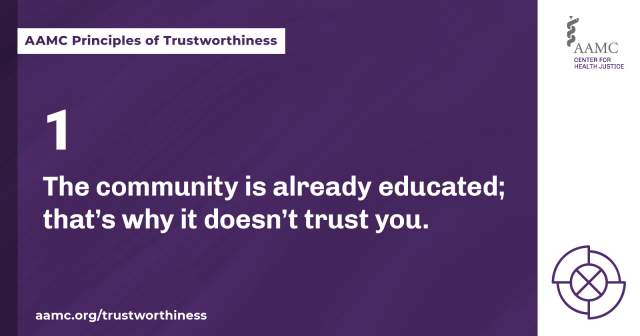Why It Matters

To achieve the Triple Aim, address health equity, and find out what matters most to patients, health care needs to engage with individuals and communities. But making such connections is no simple matter. Given the long history — and current examples — of inequities experienced by many, trust does not always come easily and may not come at all. In the following interview, Philip Alberti, the Founding Director of the Association of American Medical Colleges (AAMC) Center for Health Justice, describes his organization’s Principles of Trustworthiness, 10 key standards for helping to heal long-standing distrust of such institutions as medicine and public health among populations that have been marginalized and under-resourced.
How would you describe the Principles of Trustworthiness?
We learned when developing these principles with community members that organizations need to flip the script. This isn't about educating or convincing the community to trust you. It's about showing the community that you are worthy of that trust. Framing things in that mindset has driven the work, the voice, and our process.
[The principles] are product of community wisdom. Yes, it's grounded in evidence and theory, but more importantly, it's grounded in community voices. This isn't the AAMC's perspective or the AAMC Center for Health Justice perspective. These are lessons that we relearned through the experiences of a diverse group of 30 community members from across the United States. These principles are meant provide a framework to inspire action. They provide a guide to spark dialogue and to work with the community to co-develop local solutions and confront the local reality that is mistrust. These principles and the Principles of Trustworthiness toolkit will continue to live and breathe because they are meant to be improved upon over time.
What motivated the AAMC to develop these principles?
The foundations of these principles — humility, transparency, follow-through, respect — are not new. There have been decades and decades of research and practice around trust building and community engagement. But, back in the spring of 2020, when we started this work, we saw [public discussion] focus on building trust in the vaccine trials and building trust in the eventual vaccines. These were important discussions to be having, but we felt that we were losing sight of the more fundamental issue. The issue is not just about lack of trust in a vaccine. It’s lack of trust in the systems that created, produced, allocated, distributed, messaged, and administered that vaccine. We wanted the conversation to dig deeper and to put the onus where it belongs. The communities don’t need to become more trusting. The systems need to prove that they’re trustworthy. We need to earn trust.
Also, there’ve been so many experts — last year and currently — talking about what communities need. How should we approach communities? What is the best strategy for communities? So many experts have had opinions about communities, but many of them didn’t seem to be taking their cues from community members themselves. We wanted to center the community voice with this work. We wanted the community to tell us what health care and other organizations should be doing to show them that we are worthy of the trust we were seeking.
Would you please talk about the language of the principles? Their wording is very straightforward.
Our goal has been to be a conduit for community wisdom and expertise as we’ve produced five or six Community Engagement Toolkits over the years. There’s a video that’s part of the Principles of Trustworthiness toolkit that’s been cut down to 11 minutes from 30 or 35 hours of community interviews. The principles are blunt, direct, and no nonsense because the language flowed from the tone and tenor of the community interviews.
I think there are benefits to that bluntness and authenticity. They grab your attention in a way that theoretical or engagement frameworks typically don’t. Also, there’s a clear straight line from the 10 principles to the actions and behavior changes that are indicated by these principles. We wanted to move this conversation out of the theoretical and into the practical. That’s the goal of the toolkit’s discussion and activity guide.

Principle 1 from the AAMC Center for Health Justice's Principles of Trustworthiness: “Words matter. Be mindful of how you frame your relationship. It is not your job to teach to the gaps you assume the community has. Mistrust is a rational response to actual injustice. The community knows what it doesn’t know and will ask when it thinks you have answers it can trust. (This goes for ‘empowering’ the community, too.)”
How do you hope people use these principles?
First and foremost, these principles should not be used as a checklist. I know medicine loves checklists, but this is not that. You don’t start at one, work your way down to 10, and then get the diploma certifying that you and your organization are “100 percent certified trustworthy.” This is a long-term iterative process. Using these principles effectively will require the same level of community engagement and dialogue that went into producing the principles in the first place. I would hope that organizations use, revisit, and explore the application of these principles across all their work and put systems in place to assess how they’re doing. I hope organizations ask their community how they’re doing.
Also, I want to note that the words “medicine,” “health care,” or “hospital” don’t appear in the principles. COVID-19 or coronavirus or any specific disease or outcome also don’t appear. Mistrust is not limited to science, medicine, public health, education, or criminal justice. Our government organizations could all benefit from interrogating their own trustworthiness. So, I truly believe that these principles are evergreen and for every sector.
And wouldn’t it be fantastic for a community to work with these principles in that multi-sector way? The work of becoming trustworthy would then become a community-wide effort and not limited to just one or two institutions. Without dialogue and co-developed actions, these principles are just words.
We developed tools and resources to focus local dialogue and to suggest changes and actions that can shift an organization towards trustworthiness. But we want people to know these tools are not sacred. We purposefully left space for local innovation and are eager to incorporate those innovations and to improve the tools over time. I hope folks tell us what’s working and what’s not. We can crowdsource the identification of successful strategies so we can build a real community of practice around the tools.
Editor’s note: This interview has been edited for length and clarity.
